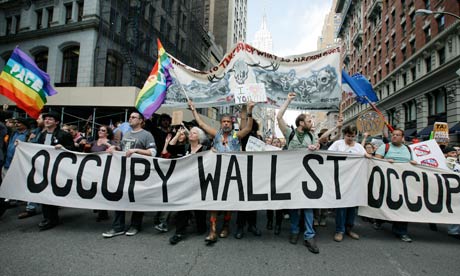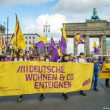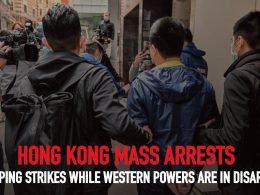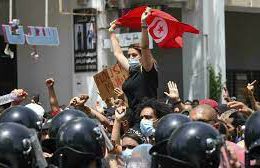By Leon Pinsky, Socialist Alternative (our sister organisation in the United States)
September saw the 10th anniversary of Occupy Wall Street, the movement which opened a new chapter in the history of social struggle in the U.S. A decade later, we can appreciate the importance of Occupy as the first step in developing a new left, anticapitalist struggles, impacting electoral politics, and aiding the formation of a new generation of fighters.
Occupy was the first nationwide struggle in the U.S. coming out of the “Great Recession” of 2008-09 which devastated millions of people. This came on top of thirty years of neoliberal attacks on the gains of working people and the massive retreat of the labor movement. But with the election of Barack Obama in the middle of economic freefall, a mixture of shock, as well as temporary illusions in the first Black president, contributed to a delay in mass struggles by several years. This was reinforced by the labor leaders and the “left” of the Democratic Party who worked overtime to make sure there was no resistance while millions lost their jobs and their homes and the banks were bailed out to the tune of trillions.
The period of the Great Recession leading up to Occupy was one of growing polarization. The red-scare and racist toxicity by the right-wing in the wake of Obama’s victory who claimed he was a “socialist”; a heated healthcare debate – all this and more played a role in growing anger throughout the U.S. The vacuum created by the absence of the left and the labor movement was initially filled by the right populist Tea Party formed in 2009 that opposed the bank bailout while opposing any bailout for ordinary people. The Tea Party anticipated Trumpism.
The track of a storm
In the months before Occupy began, struggles had developed in Southern Europe against austerity measures imposed by the European Union, the European Central Bank, and the International Monetary Fund – collectively known as the Troika. Actions took place in central squares in Portugal, Spain, and Greece as the super-rich attempted to make working people pay for the crisis.
However, the most serious social explosion came in early 2011 in the form of mass revolutionary movements across the Middle East and North Africa, frequently called the Arab Spring, with the Tunisian and Egyptian Revolutions in the lead. Their form of organizing as mass “occupations” of central squares was used in past revolutionary movements, but were also inspired by the events in Southern Europe. The toppling of dictators across the region reignited hope across the world. Meanwhile the struggle in Europe escalated into mass movements, such as the Indignados in Spain, dozens of general strikes in Greece, and the rise of new left political parties.
In the U.S. the first spark came with Wisconsin’s then-governor Scott Walker, a vicious Tea Party Republican, setting out to bust the state’s public sector unions while making massive cuts to education at the start of 2011. This ignited a months-long uprising driven by public sector unions, young people, and the broader community of workers. The historic fightback by working people used some of the tactics used in Europe and the Middle East as tens of thousands gathered in front of the state house for ongoing protests, as well as “occupying” the State Capitol and discussing which direction the struggle should take. There was wide support for the idea of a public sector general strike but the unions refused to call it and diverted the movement into electoral channels.
In New York City, an attempt to develop the struggle against austerity imposed by billionaire mayor Michael Bloomberg brought together a small group of activists to form “Bloombergville” in the spring of 2011. This attempt at a tent city outside City Hall took inspiration from the “Hooverville” tent cities during the Great Depression. It was an anticipation of what was to come a few months later.
In the context of this rising mood of struggle, the anti-globalization magazine Adbusters made a call to “Occupy Wall Street” on September 17. They argued for a “new formula”: “…what makes this novel tactic exciting, is its pragmatic simplicity: we talk to each other in various physical gatherings and virtual people’s assemblies … we zero in on what our one demand will be, a demand that awakens the imagination and, if achieved, would propel us toward the radical democracy of the future … and then we go out and seize a square of singular symbolic significance and put our asses on the line to make it happen.” While the limitations of this idea would soon become evident, there is no doubt that it struck a chord.
The golden thread
On September 17, hundreds made their way to Zuccotti Park, a few blocks from Wall Street in Lower Manhattan’s financial district, and set up camp. For the following two months, Occupy activists organized street assemblies, protests, and occupied spaces across the country. In New York City, 85 were arrested at the end of the first week. The front page of the newspapers the following morning showed a young man with blood on his face while he was arrested by NYPD officers. The brutal police reaction drew national and international attention and many young people came to NYC to set up a tent at Zuccotti Park or participate in mass weekend actions. It also became clear that Occupy Wall Street had support among a wide section of ordinary New Yorkers with thousands heading down each weekend to visit the encampment. By the end of the second week, a mass march over the Brooklyn Bridge was blocked by the NYPD from both sides with 700 protestors arrested one by one on the bridge.
Many saw Occupy as the left’s response to the Tea Party. Unlike the Tea Party, which put the blame for the economic crisis on immigrants and “too much socialism” in government, Occupy rightfully shifted the blame to big banks and the richest 1% in society. It began to draw class-struggle conclusions about the need for the 99% to fight back. This was an appeal to millions who were looking for an organized response to the growing threat from the right as well as the broader injustice baked into capitalist society.
The movement soon spread to cities across the country, where Occupy networks led to neighborhood meetings, out of which new campaigns and struggles developed such as Occupy Homes in Minneapolis, where Socialist Alternative played a major role defending working people against evictions and foreclosures.
Occupy drew huge inspiration from the international movements of that year. Important connections were made in popular consciousness between the movements in Wisconsin and New York to the mass movement that forced Mubarak’s fall, captured in the slogan “Fight like an Egyptian.”
While this internationalist consciousness was a strength, the movement didn’t always draw the correct lessons from these struggles abroad. This shows the importance of seriously studying international class struggle and revolutionary movements.
While the movement was incredibly popular, a lot more was needed to bring real change.
After decades of defeats for the working class and a shift by union leaderships to the right, the new generation of fighters had no existing reference points for creating a democratic mass movement, with a fighting organization, leadership, and program.
Many activists, for example, refused initially to discuss demands around education, housing, and healthcare. They drew the wrong conclusion from international struggles that only one generalized demand (“We are the 99%”) was needed to win wide support. In reality, the mass support the movement received was mostly passive. Demands around day-to-day issues, tied to a program for fundamental systemic change would have engaged a wider layer of working people who would have felt that they were fighting for something substantive. The lack of concrete demands also meant that issues such as immigration and racism were not highlighted, unless individual activists wanted to emphasize them. This was a real missed opportunity to prepare the forces to take on institutional racism and the fight against police brutality.
Besides the lack of concrete demands, Occupy activists did not democratically elect a leadership nor develop accountable structures. This meant that in most cases an unelected de facto leadership played an unaccountable role in steering the movement. With no elected leadership, no one had the authority to speak for the movement and put forward a democratically decided platform. Instead, decisions had to be based on the consensus reached by hundreds of people after hours of tiring conversations, with one opponent being enough to block decisions. Actions were largely uncoordinated and weekends saw sporadic actions taking place by small groups. This turned off many working people who couldn’t afford to waste their time, let alone skip work to sleep in a tent with no guarantee this sacrifice would result in real victories.
These weaknesses flowed in part from the mistaken anarchist approach of some of the unelected leaders of the movement. Their view was that “occupying” public spaces could be the beginning of setting up an alternative democratic form of society (funded by donations from working people), which would then spontaneously spread to other areas.
While some organizations on the left either denounced Occupy or played a passive cheerleading role, Socialist Alternative took an active part from the first day to the last. We continuously came up with demands and proposals for the movement, such as the call to expand the Occupy movement to other cities and form a network to coordinate days of actions, strategy, and program. We also called on the movement to discuss demands that could be used as an organizing tool to bring working people together. We made a call to expand the movement to schools, neighborhoods, and everywhere else where there was organizing potential. This connected with the outlook of many of the best activists who wanted to do more than gather every night in a square.
We also warned that without a clear strategy, the movement would die off. Some of the main reasons were that as the winter was approaching, many people would fold their tents and go home; that without a coherent response, the increasing organized police repression instigated by the mayors of the main cities would wear the movement down; and that the idea of setting up an alternative society within capitalism is a fundamentally wrong approach which does not challenge capitalism and cannot advance without a mass struggle of the working class.
Bloomberg’s first attempt to shut down Zuccotti park in October was called off after the AFL-CIO issued a call for trade unionists to defend the park in the early morning just before the mayor’s ultimatum for the movement to dispense was about to expire. This temporarily forced the NYPD to back off.
In Oakland, a general assembly of 1,500 people called for a citywide general strike on November 2 as a response to the brutal police repression.
The reaction to police repression has been so significant, that it forced Mayor Quan to publicly announce a reduced police presence, allow the occupation to continue, and give city workers permission to take the day off work and participate in the strike.
The November 2 strike shut down the port of Oakland and gave momentum for the historic ports strike on December 12 up and down the West Coast, which was jointly led by ILWU and Occupy activists.
While some unions supported the November strike in Oakland, many of the conservative union leaderships did not. Instead of initiating and mobilizing for it, a few union leaders encouraged their members to take a sick day so they could participate. A true citywide general strike could’ve made a historic impact on events and inspired tens of millions to get organized and fight back through the unions.
However, on November 15 a network of mayors, led by Bloomberg, coordinated an assault on encampments across the country which the movement never bounced back from. This followed massive surveillance coordinated by the FBI, involving local police and the Department of Homeland Security. Released documents show that Occupy activists were being treated as a “domestic terrorism” threat.
Recalled to life
Occupy had a major impact on U.S. society. Primarily, it gave an expression to the growing anger against massive inequality, the erosion of workers rights and against the banks who caused the Great Recession and the politicians who bailed them out. It proved to tens of millions of Americans that they were not alone in wanting to fight back against austerity and foreclosures. It was the beginning of a more generalized opposition to neoliberalism.
The movement inspired housing activists to actively fight home foreclosures; students to fight tuition hikes; educators and parents to fight the corporate “education reform” agenda of cuts and privatization.
Far-sighted capitalist politicians saw the potential to ride on the “Occupy wave.” Mayoral candidate Bill deBlasio centered his 2013 campaign around the slogan of “Tale of Two Cities.” Socialist Alternative pointed to the need to bring the challenge to corporate power onto the political field and called on the movement to run 200 independent candidates throughout the country in 2012. Socialist Alternative showed the way by running Kshama Sawant, a leading activist in Occupy Seattle, for the Washington state legislature in 2012 and received a historic vote for an openly independent Socialist. Using the momentum of the campaign, we ran Kshama again the following year, winning a seat on the Seattle City Council and going on to build a movement to win the first $15 minimum wage in a major city in 2014. This was the first major national electoral breakthrough for socialists and showed that the left could win outside the Democratic Party.
In 2011 and 2012, leading Occupy activists, influenced by anarchist ideas, opposed standing in elections. In one sense this prevented the movement being straightforwardly co-opted by the Democrats. But it was a huge missed opportunity to strike a blow for pro-working class politics. However in 2016, many of the main organizers swarmed to Bernie Sanders’ presidential campaign which gave a political expression to the anger at inequality, austerity and neoliberalism generally. In reality, Occupy had helped lay the basis for Bernie’s two campaigns. Tragically, Sanders allowed this huge political upsurge to remain trapped inside the corporate Democratic Party.
In the ten years after Occupy, we’ve seen the emergence of Black Lives Matter as a mass movement, the MeToo wave and the redevelopment of labor struggle beginning with the Red State teachers’ revolt of 2018. The socialist movement has grown to its highest level since the 70s. Both Socialist Alternative and the Democratic Socialists of America experienced historic growth. Dozens of “democratic socialists” have been elected though almost all operate within the framework of the Democrats.
In Seattle, Kshama Sawant and Black Lives Matter are under the fiercest attack yet as the ruling class with the right-wing attempting to undemocratically remove Kshama from the City Council. Many of those radicalized a decade ago by Occupy are now playing a leading role in struggles.
We should give a special respect to the legacy of the Occupy movement, learn from its mistakes, and draw out the key lessons. For the coming period, an independent political organization for the working class is needed more than ever, where democratic discussions and decision-making takes place throughout the country on a regular basis, where campaigns are organized, where we defend our own and fight for a better future, for a democratic socialist society run by the billions, not the billionaires.












